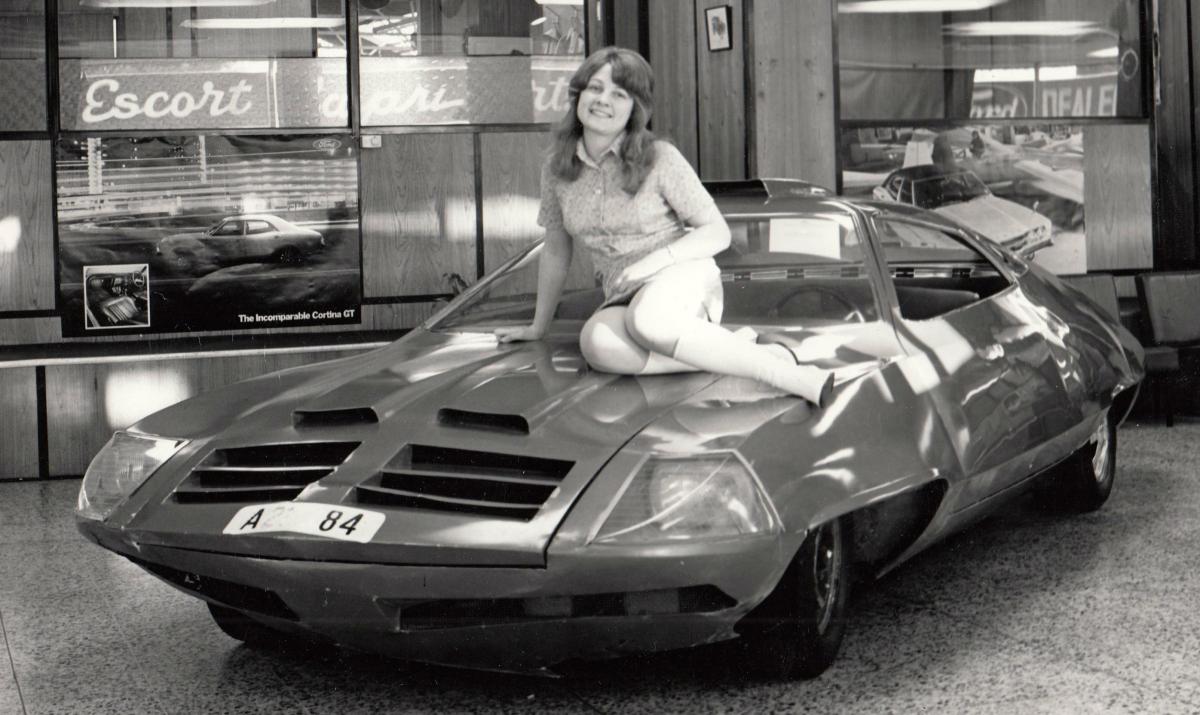A STRANGE-SHAPED car landed in a garage in the middle of Darlington in November 1971.
Its peculiar curves and sharp pointed nose made it look like an alien invader. It was as if it had been beamed down from out of space.
Which in a way it had.
“You must remember Commander Straker in the Gerry Anderson production UFO back in the early 1970s,” says Mike McLaren, one of several people who took us to task for an enormous gap in our cultural knowledge. “The car is Commander Straker’s car.”
TV legend Gerry Anderson is most famous for his mid-1960s TV series, Thunderbirds, and UFO was a 26-episode follow-up screened in the UK in 1970 on ITV.
“It starred Ed Bishop, George Sewell, Michael Billington, Wanda Ventham, Gabrielle Drake and Dolores Mantez and was set in 1980, a time when alien invaders have begun to kidnap humans for nefarious purposes,” says Tony Marshall of Darlington. “Earth's only hope is SHADO (Supreme Headquarters Alien Defence Organisation), led by Commander Ed Straker (Ed Bishop).”
Most of the vehicular action was done with models of spaceships or tracked land assault wagons or a submarine which somehow managed to fire a jet-fighter from its bows while under water.
But there were two real cool cars – one was gold and the other was purple-pink.
“They were built by Alan Mann Racing on a Ford Zephyr IV chassis and powered by a Ford Cortina 1600 engine,” says Ian Pinkney in Durham. “The body was hand-made out of aluminium.”
SHADO’s secret headquarters were beneath a film studio and Commander Straker’s cover was that he was head of the film studio. Therefore, his car had to look like the sort of snazzy vehicle a film studio boss would drive.
It had loads of gadgets – a carphone, a radar and the ability to out-run an intergalactic spaceship which was attacking it at the speed of light.
It also had futuristic gullwings that opened with a space age swoosh at the press of a button – actually, they didn’t: someone off-camera lifted the doors up when the button was pressed while making a swooshing noise and, apparently, you can see them unintentionally in action in a reflection on the car.
In 1971, the supercool cars – valued at £8,500 each – toured Ford garages, and so came to the Skippers garage beside Darlington’s inner ring road to draw in the UFO fans.
“On closer inspection, you could see the cut down rear wheel arches at the back of the fibreglass body shell,” says Tony. “I remember that several of the control knobs on the interior were the cap tops from a popular brand of ladies’ hairspray.”
Our correspondents signed off their emails and letters with comments like “how sad am I to know these things”, and “unfortunately “no detail on the young lady – other than she looks much prettier than the car!”.
Sexism had a different definition in the early 1970s – the supersexy stars of the UFO programmes were the young ladies with purple hair who glittered in shapely silvery spacesuits in SHADO’s Moonbase – and so the advert in the Echo promoting the cars’ appearance had a picture of a Skippers’ employee sitting prettily in knee length heeled boots on the £8,500 bonnet.
The headline above the advert said “Beauty and the best” and the photographer appears to have written on the rear of the picture: “Bunny on bonnet.”
With 21st Century sensibilities, we can reveal that the model disporting herself with absolute decorum is Linda Soderman – then she was Linda Carr, and she worked in the Skippers’ sales office.
“My husband, Mike, brought me the paper in bed on Saturday and I was reading it through with a cup of coffee and I said ‘oh, my goodness, it’s that picture’,” she says.
She was expecting her (female, naturally) boss to have her picture taken on the bonnet, but at the last moment, Linda was put forward.
“I wasn’t prepared at all,” she says. “I would be 19. I had a short dress on and white knee length boots – that was the fashion of the day.”
The cars were only in Darlington for five days before they were beamed off to another Ford garage.
David Walsh in east Cleveland says that in 1974, the gold car was bought by Radio 1 breakfast DJ Dave Lee Travis, who was known as the Hairy Cornflake until his fall from grace in 2014 as part of Operation Yewtree. He used it for personal appearances in the 1970s before selling it in the early 1980s. It was last heard of rotting beneath a tarpaulin somewhere in the Midlands.
The purple-pink car has disappeared from the face of the planet – perhaps it has been abducted by aliens.
THESE promotional events were a feature of Ford garages of the day. “In the mid 1960s, I remember seeing on display there a Le Mans winning Ford GT40, and a Mk4 Ford Zodiac with long range fuel tanks that was used on a proving track to see what miles-per-gallon the car was capable of,” says Steve Walton. “I also remember there was a cut down car that was a braking simulator.”
In those days, the garage was owned by John Neasham, councillor, magistrate, freemason, alderman and mayor. He was chairman of the aero club at Croft Circuit; he was a leading member of the Rotary Club, cricket club, motor club, St John Ambulance Brigade, and the chrysanthemum society. He was a director of Darlington Football Club from 1936 to 1964 and chairman from 1951, his reign including on January 29, 1958, perhaps the greatest day in the Quakers’ history when they drubbed Chelsea 4-1 in an FA Cup replay at Feethams (attendance: 15,150).
Mr Neasham was born in Norton-on-Tees in 1901. He started as an apprentice in Dove’s garage in Bondgate, Darlington, and in 1926 opened his own business in Parkgate. His tentacles spread so that he also had Ford dealerships in Northallerton and Richmond, and he owned Blackwell Hill, one of the town’s foremost Victorian mansions.
In the 1960s, the Skerneside slums in the Clay Row area of Darlington centre were demolished to make way for the inner ring road, and although Mr Neasham lost his Parkgate premises, he gained a £135,000 steel and concrete palace beside St Cuthbert’s Way.
Lady Starmer opened it on May 20, 1966, to much fanfare as it was the first building along the new road to become operational. However, Mr Neasham’s health then went into decline, along with the health of his garage, and he died on October 6, 1969 – the day that Skipper of Burnley completed the takeover of his business.
Skipper sold to Sanderson Ford in 1994. In January 2000, CD Bramall took over followed by Evans Halshaw, which left the town centre in 2008 and John Neasham’s garage was pulled down, leaving a scratty car park.
IT is a scratty car park with history, though, because John Neasham’s garage was built on the site where Darlington’s first Methodist service had been held.
John Wesley, the founder of Methodism, visited Darlington in 1743 and 1745, when he stayed in an inn where he was disturbed by the locals’ swearing. However, that visit planted seeds which grew and when he returned in 1753, there were enough homegrown Methodists for him to hold a service – in the home of a Mr Oswald in Clay Row.
It was a "small thatched cottage with a mud floor" and Mr Oswald probably worked in the smelly tannery which once covered the car park.
On the 200th anniversary of the service, a plaque was unveiled on the site of Mr Oswald’s cottage, but when it was demolished in the early 1960s, the plaque was lost.
JOHN NEASHAM’S general sales manager was the wonderfully-named Baron Gabriel H Calcagni de Tande. "Gaby", as he was known throughout the town, had come to Britain from Italy in 1941 to fly Spitfires with the Free French Airforce. He married a Darlington girl, and in 1948 Mr Neasham had spotted him selling surplus war aircraft and persuaded him to start selling cars.
A FINAL note of intrigue from Steve Walton. “If I remember correctly, there was a unsolved murder at Skippers,” he says. “The filling station was open 24 hours, and one night someone assaulted the attendant and set fire to the kiosk.” Can anyone tell us any more?
Today’s front page shows John Neasham’s garage beside the barely complete inner ring road on March 29, 1969. On the right is the Cricketers pub (now sadly empty). Behind are the three stick-thin chimneys and the three bulbous cooling towers of the 1940 power station that dominated Darlington’s skyline until their demolition in 1976. The site of the garage and the land behind the pub used to be a tannery














Comments: Our rules
We want our comments to be a lively and valuable part of our community - a place where readers can debate and engage with the most important local issues. The ability to comment on our stories is a privilege, not a right, however, and that privilege may be withdrawn if it is abused or misused.
Please report any comments that break our rules.
Read the rules here